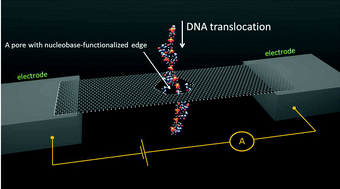The wonder material graphene has recently led to another exciting scientific breakthrough, this time involving the building blocks of life. Whereas the process of reading DNA has so far been a laborious, expensive, and time consuming chemical process, a new breakthrough using graphene could transform the gene sequencing industry.
New research from the National Institute of Standards and Technology (NIST) has simulated how DNA sequencing could become much faster and more accurate through a nanopore sequencing process: a single DNA molecule gets pulled through a tiny, chemically active hole in a super thin sheet of graphene, allowing changes in electrical current to be detected.
This method suggests that about 66 billion bases, or the smallest units of genetic info, could be identified in just one second through this method. Even more impressive, the study has found the results to be 90% accurate with no false positives. If the simulation proves as effective in experiments, this could be a huge breakthrough in several fields that utilize genetic information, including forensics.
While the concept of nanopore sequencing—pulling electrically charged molecules through a pore in a thin material—has been around for at least 20 years, using graphene as that sheet solves some of the major side effects that have hampered the process. Because of graphene’s unique chemical properties and it’s extreme thinness, four graphene nanoribbons could be bonded together to form an integrated DNA sensor. While the scientific properties at play in this process are quite complex, this video of the simulation breaks it down pretty clearly. If you’re interested in a more complex scientific explanation, check out this article from phys.org.
The major benefit of this new approach to DNA sequencing is that it would make the process much more real-world applicable. It would eliminate the need for costly computers and complex lab setups. Once NIST perfects its method and proves its success in real world conditions, we can expect to see huge strides made in DNA sequencing.
